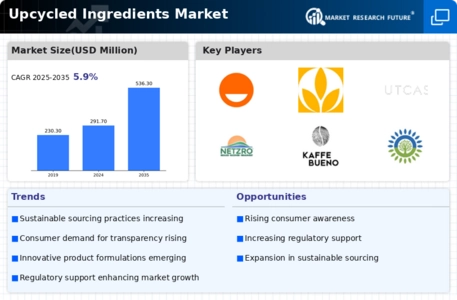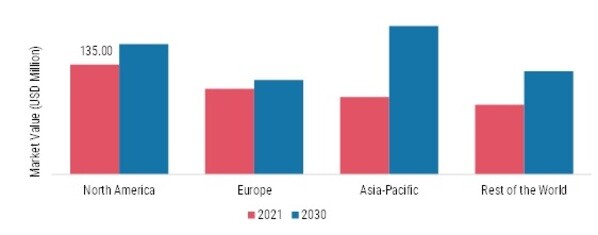-
. EXECUTIVE SUMMARY
-
. Global Upcycled Ingredients Market, by Ingredient Type
-
. Global Upcycled Ingredients Market, by Source
-
. Global Upcycled Ingredients Market, by End Use
-
. Global Upcycled Ingredients Market, by Distribution Channel
-
. Global Upcycled Ingredients Market, by Region
-
. MARKET INTRODUCTION
-
. Definition
-
. Scope of the Study
-
. Market Structure
-
. Key Buying Criteria
-
. Macro Factor Indicator Analysis
-
. RESEARCH METHODOLOGY
-
. Research Process
-
. Primary Research
-
. Secondary Research
-
. Market Size Estimation
-
. Forecast Model
-
. List of Assumptions
-
. MARKET DYNAMICS
-
. Introduction
-
. Drivers
-
. Restraints
-
. Opportunities
-
. Challenges
-
. MARKET FACTOR ANALYSIS
-
. Value Chain Analysis
-
. Raw Material Suppliers
-
. Manufacturers
-
. Distributors/Retailers/Wholesalers/E-Commerce Merchants
-
. End-Users
-
. Supply Chain Analysis
-
. Porter’s Five Forces Model
-
. Bargaining Power of Suppliers
-
. Bargaining Power of Buyers
-
. Threat of New Entrants
-
. Threat of Substitutes
-
. Intensity of Rivalry
-
. Impact of Covid-19 on Global Upcycled Ingredients Market
-
. GLOBAL UPCYCLED INGREDIENTS MARKET, BY INGREDIENT TYPE
-
. Introduction
-
. Upcycled Starch
-
. Upcycled Starch: Market Estimates & Forecast by Region, 2020-2030
-
. Upcycled Proteins / Powder
-
. Upcycled Proteins / Powder: Market Estimates & Forecast by Region, 2020-2030
-
. Upcycled Flour
-
. Upcycled Flour: Market Estimates & Forecast by Region, 2020-2030
-
. Upcycled Dietary Fiber
-
. Upcycled Dietary Fiber: Market Estimates & Forecast by Region, 2020-2030
-
. Upcycled Ethanol
-
. Upcycled Ethanol: Market Estimates & Forecast by Region, 2020-2030
-
. Upcycled Oils
-
. Upcycled Oils: Market Estimates & Forecast by Region, 2020-2030
-
. Upcycled Vitamins
-
. Upcycled Vitamins: Market Estimates & Forecast by Region, 2020-2030
-
. Upcycled Electrolytes
-
. Upcycled Electrolytes: Market Estimates & Forecast by Region, 2020-2030
-
. Upcycled Antioxidants
-
. Upcycled Antioxidants: Market Estimates & Forecast by Region, 2020-2030
-
. Upcycled Minerals
-
. Upcycled Minerals: Market Estimates & Forecast by Region, 2020-2030
-
. GLOBAL UPCYCLED INGREDIENTS MARKET, BY SOURCE
-
. Introduction
-
. Plant-based
-
. Plant-based: Market Estimates & Forecast by Region, 2020-2030
-
. Seeds
-
. Seeds: Market Estimates & Forecast by Region, 2020-2030
-
. Peels
-
. Peels: Market Estimates & Forecast by Region, 2020-2030
-
. Flowers
-
. Flowers: Market Estimates & Forecast by Region, 2020-2030
-
. Fruits
-
. Fruits: Market Estimates & Forecast by Region, 2020-2030
-
. Grains
-
. Grains: Market Estimates & Forecast by Region, 2020-2030
-
. Animal-based
-
. Animal-based: Market Estimates & Forecast by Region, 2020-2030
-
. Egg Shells
-
. Egg Shells: Market Estimates & Forecast by Region, 2020-2030
-
. Animal Bones
-
. Animal Bones: Market Estimates & Forecast by Region, 2020-2030
-
. Others
-
. Others: Market Estimates & Forecast by Region, 2020-2030
-
. GLOBAL UPCYCLED INGREDIENTS MARKET, BY END USE
-
. Introduction
-
. Food and Beverages
-
. Food and Beverages: Market Estimates & Forecast by Region, 2020-2030
-
. Cosmetics and personal care
-
. Cosmetics and personal care: Market Estimates & Forecast by Region, 2020-2030
-
. Nutraceuticals
-
. Nutraceuticals: Market Estimates & Forecast by Region, 2020-2030
-
. Animal Feed and Pet Food
-
. Animal Feed and Pet Food: Market Estimates & Forecast by Region, 2020-2030
-
. GLOBAL UPCYCLED INGREDIENTS MARKET, BY REGION
-
. Introduction
-
. North America
-
. Market Estimates & Forecast, by Country, 2020–2030
-
. Market Estimates & Forecast, by Ingredient Type, 2020–2030
-
. Market Estimates & Forecast, by Source, 2020–2030
-
. Market Estimates & Forecast, by End Use, 2020–2030
-
. Market Estimates & Forecast, by Distribution Channel, 2020–2030
-
. US
-
. Market Estimates & Forecast, by Ingredient Type, 2020–2030
-
. Market Estimates & Forecast, by Source, 2020–2030
-
. Market Estimates & Forecast, by End Use, 2020–2030
-
. Market Estimates & Forecast, by Distribution Channel, 2020–2030
-
. Canada
-
. Market Estimates & Forecast, by Ingredient Type, 2020–2030
-
. Market Estimates & Forecast, by Source, 2020–2030
-
. Market Estimates & Forecast, by End Use, 2020–2030
-
. Market Estimates & Forecast, by Distribution Channel, 2020–2030
-
. Mexico
-
. Market Estimates & Forecast, by Ingredient Type, 2020–2030
-
. Market Estimates & Forecast, by Source, 2020–2030
-
. Market Estimates & Forecast, by End Use, 2020–2030
-
. Market Estimates & Forecast, by Distribution Channel, 2020–2030
-
. Europe
-
. Market Estimates & Forecast, by Ingredient Type, 2020–2030
-
. Market Estimates & Forecast, by Source, 2020–2030
-
. Market Estimates & Forecast, by End Use, 2020–2030
-
. Market Estimates & Forecast, by Distribution Channel, 2020–2030
-
. Germany
-
. Market Estimates & Forecast, by Ingredient Type, 2020–2030
-
. Market Estimates & Forecast, by Source, 2020–2030
-
. Market Estimates & Forecast, by End Use, 2020–2030
-
. Market Estimates & Forecast, by Distribution Channel, 2020–2030
-
. France
-
. Market Estimates & Forecast, by Ingredient Type, 2020–2030
-
. Market Estimates & Forecast, by Source, 2020–2030
-
. Market Estimates & Forecast, by End Use, 2020–2030
-
. Market Estimates & Forecast, by Distribution Channel, 2020–2030
-
. Italy
-
. Market Estimates & Forecast, by Ingredient Type, 2020–2030
-
. Market Estimates & Forecast, by Source, 2020–2030
-
. Market Estimates & Forecast, by End Use, 2020–2030
-
. Market Estimates & Forecast, by Distribution Channel, 2020–2030
-
. Spain
-
. Market Estimates & Forecast, by Ingredient Type, 2020–2030
-
. Market Estimates & Forecast, by Source, 2020–2030
-
. Market Estimates & Forecast, by End Use, 2020–2030
-
. Market Estimates & Forecast, by Distribution Channel, 2020–2030
-
. UK
-
. Market Estimates & Forecast, by Ingredient Type, 2020–2030
-
. Market Estimates & Forecast, by Source, 2020–2030
-
. Market Estimates & Forecast, by End Use, 2020–2030
-
. Market Estimates & Forecast, by Distribution Channel, 2020–2030
-
. Rest of Europe
-
. Market Estimates & Forecast, by Ingredient Type, 2020–2030
-
. Market Estimates & Forecast, by Source, 2020–2030
-
. Market Estimates & Forecast, by End Use, 2020–2030
-
. Market Estimates & Forecast, by Distribution Channel, 2020–2030
-
. Asia-Pacific
-
. Market Estimates & Forecast, by Ingredient Type, 2020–2030
-
. Market Estimates & Forecast, by Source, 2020–2030
-
. Market Estimates & Forecast, by End Use, 2020–2030
-
. Market Estimates & Forecast, by Distribution Channel, 2020–2030
-
. China
-
. Market Estimates & Forecast, by Ingredient Type, 2020–2030
-
. Market Estimates & Forecast, by Source, 2020–2030
-
. Market Estimates & Forecast, by End Use, 2020–2030
-
. Market Estimates & Forecast, by Distribution Channel, 2020–2030
-
. India
-
. Market Estimates & Forecast, by Ingredient Type, 2020–2030
-
. Market Estimates & Forecast, by Source, 2020–2030
-
. Market Estimates & Forecast, by End Use, 2020–2030
-
. Market Estimates & Forecast, by Distribution Channel, 2020–2030
-
. Japan
-
. Market Estimates & Forecast, by Ingredient Type, 2020–2030
-
. Market Estimates & Forecast, by Source, 2020–2030
-
. Market Estimates & Forecast, by End Use, 2020–2030
-
. Market Estimates & Forecast, by Distribution Channel, 2020–2030
-
. Australia & New Zealand
-
. Market Estimates & Forecast, by Ingredient Type, 2020–2030
-
. Market Estimates & Forecast, by Source, 2020–2030
-
. Market Estimates & Forecast, by End Use, 2020–2030
-
. Market Estimates & Forecast, by Distribution Channel, 2020–2030
-
. Rest of Asia-Pacific
-
. Market Estimates & Forecast, by Ingredient Type, 2020–2030
-
. Market Estimates & Forecast, by Source, 2020–2030
-
. Market Estimates & Forecast, by End Use, 2020–2030
-
. Market Estimates & Forecast, by Distribution Channel, 2020–2030
-
. Rest of the World
-
. Market Estimates & Forecast, by Ingredient Type, 2020–2030
-
. Market Estimates & Forecast, by Source, 2020–2030
-
. Market Estimates & Forecast, by End Use, 2020–2030
-
. Market Estimates & Forecast, by Distribution Channel, 2020–2030
-
. South America
-
. Market Estimates & Forecast, by Ingredient Type, 2020–2030
-
. Market Estimates & Forecast, by Source, 2020–2030
-
. Market Estimates & Forecast, by End Use, 2020–2030
-
. Market Estimates & Forecast, by Distribution Channel, 2020–2030
-
. Middle East
-
. Market Estimates & Forecast, by Ingredient Type, 2020–2030
-
. Market Estimates & Forecast, by Source, 2020–2030
-
. Market Estimates & Forecast, by End Use, 2020–2030
-
. Market Estimates & Forecast, by Distribution Channel, 2020–2030
-
. Africa
-
. Market Estimates & Forecast, by Ingredient Type, 2020–2030
-
. Market Estimates & Forecast, by Source, 2020–2030
-
. Market Estimates & Forecast, by End Use, 2020–2030
-
. Market Estimates & Forecast, by Distribution Channel, 2020–2030
-
. COMPETITIVE LANDSCAPE
-
. Introduction
-
. Competitive Benchmarking
-
. Key Developments & Growth Strategies (Expansions/Mergers & Acquisitions/Joint Ventures/New Developments/Agreements/Investments)
-
. COMPANY PROFILES
-
. Rise
-
. Company Overview
-
. Financial Overview
-
. Products Offered
-
. Key Developments
-
. SWOT Analysis
-
. Key Strategies
-
. ReGrained
-
. Comet Bio
-
. Outcast
-
. Netzro
-
. Kaffe Bueno
-
. SunOpta
-
. Greentech
-
. American River AG
-
. APPENDIX
-
. General Sources & References
-
. List of Abbreviation












Leave a Comment